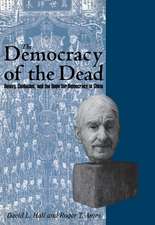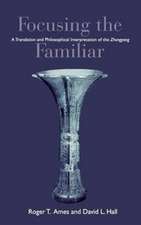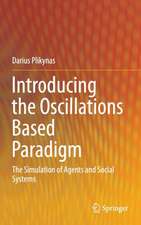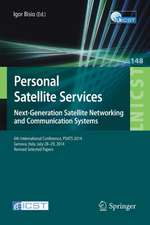Handbook of Multisensor Data Fusion: Theory and Practice, Second Edition: Electrical Engineering & Applied Signal Processing Series
Editat de Martin Liggins II, David Hall, James Llinasen Limba Engleză Hardback – 26 sep 2008
New to the Second Edition—
· Applications in electromagnetic systems and chemical and biological sensors
· Army command and combat identification techniques
· Techniques for automated reasoning
· Advances in Kalman filtering
· Fusion in a network centric environment
· Service-oriented architecture concepts
· Intelligent agents for improved decision making
· Commercial off-the-shelf (COTS) software tools
From basic information to state-of-the-art theories, this second edition continues to be a unique, comprehensive, and up-to-date resource for data fusion systems designers.
Preț: 1590.65 lei
Preț vechi: 1939.81 lei
-18% Nou
Puncte Express: 2386
Preț estimativ în valută:
304.40€ • 315.87$ • 254.43£
304.40€ • 315.87$ • 254.43£
Carte tipărită la comandă
Livrare economică 17-31 martie
Preluare comenzi: 021 569.72.76
Specificații
ISBN-13: 9781420053081
ISBN-10: 1420053086
Pagini: 870
Ilustrații: 299 b/w images and 86 tables
Dimensiuni: 189 x 246 x 46 mm
Greutate: 1.77 kg
Ediția:Revizuită
Editura: CRC Press
Colecția CRC Press
Seria Electrical Engineering & Applied Signal Processing Series
ISBN-10: 1420053086
Pagini: 870
Ilustrații: 299 b/w images and 86 tables
Dimensiuni: 189 x 246 x 46 mm
Greutate: 1.77 kg
Ediția:Revizuită
Editura: CRC Press
Colecția CRC Press
Seria Electrical Engineering & Applied Signal Processing Series
Public țintă
ProfessionalCuprins
Introduction to Multisensor Data Fusion. Advanced Tracking and Association Methods. Automated Reasoning and Visualization for Situation and Threat Refinement. Sample Applications.
Notă biografică
Liggins II, Martin; Hall, David; Llinas, James
Descriere
Expanding the scope of the best-selling first edition, this volume introduces nine additional chapters and updates others to focus on developments in the fusion of data in a variety of applications from military to automotive to medical. It provides much-needed information on mathematical techniques and computer methods employed to perform fusion. The added material covers, among other areas, advances in Kalman filtering, fusion in a network centric environment, service-oriented architecture concepts, intelligent agents for improved decision making, off-the-shelf tools to assist development of data fusion systems, and current medical applications.



























